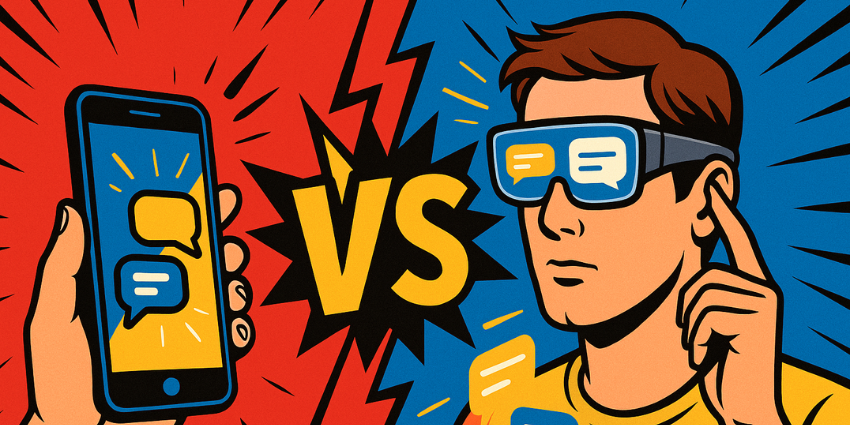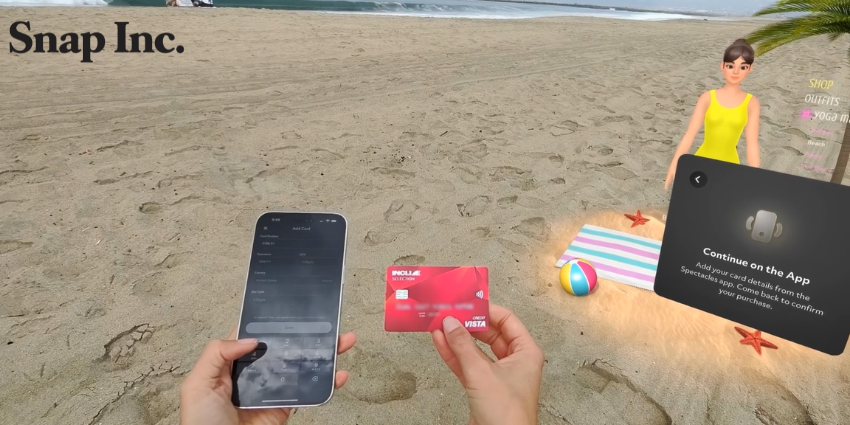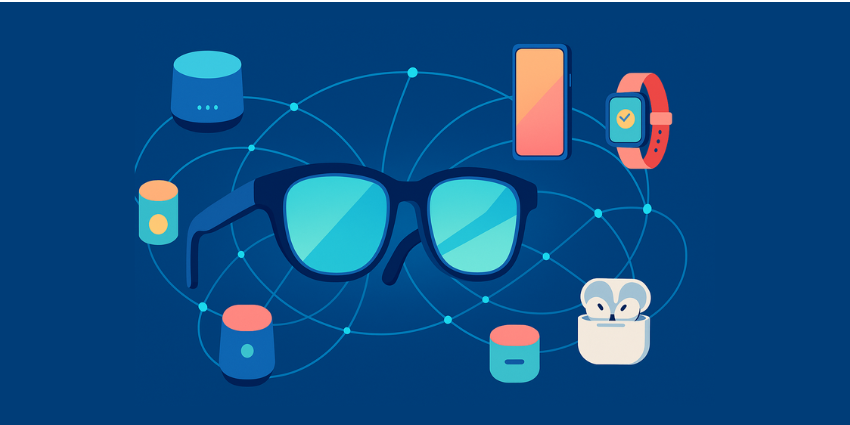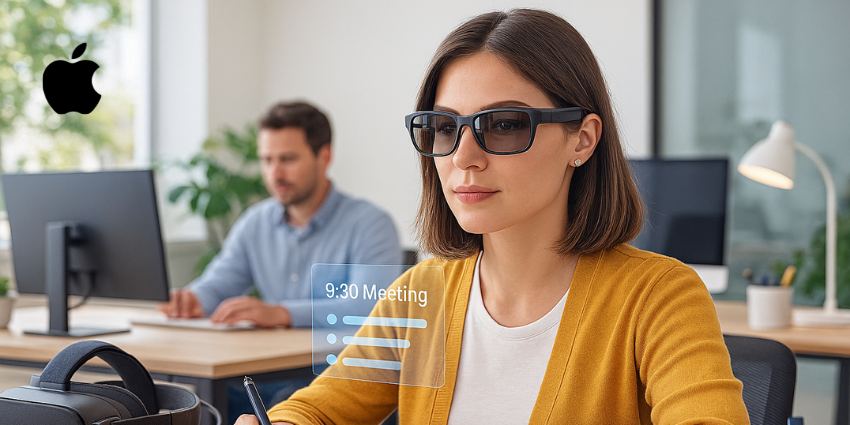As someone deeply immersed in the evolution of workplace technology, I believe we’re witnessing a pivotal moment in computing history. The traditional smartphone, our trusted digital companion for over a decade, faces its first serious challenger for primary screen dominance.
If you’re an enterprise leader or technology professional evaluating the next wave of productivity tools, the emergence of AI-powered smart glasses represents more than an incremental upgrade. This shift could fundamentally reshape how employees access information, collaborate, and perform daily tasks.
Related XR Today Coverage
The smart glasses revolution has been gaining momentum across multiple fronts. Our recent analysis explores various perspectives on this technological shift:
- Why Smart Glasses Won’t Be Your Go-To Device Yet examines the current limitations holding back widespread adoption
- The Invisible Revolution: How Smart Glasses Will Transform Work Without You Even Noticing explores the subtle but profound workplace changes ahead
- More Than Hype: Meta’s Hypernova Specs Could Replace Your Phone investigates Meta’s ambitious vision for next-generation eyewear
- The XR Inflection Point: Why 2026 Will Finally Deliver on AR’s Long-Awaited Promise analyzes the timeline for mainstream AR adoption
The Current Smartphone Paradigm in Professional Settings
Smartphones have dominated professional workflows since the iPhone’s 2007 debut, evolving into pocket-sized computers that manage everything from emails to enterprise applications. Today’s workplace relies heavily on mobile devices for communication, data access, and productivity apps. However, this dominance comes with inherent limitations that forward-thinking organizations are beginning to question.
The smartphone requires constant attention shifting between the physical environment and the digital screen. Workers frequently interrupt tasks to check notifications, respond to messages, or access critical information. This context-switching creates productivity friction that many enterprises are eager to eliminate.
AI Smart Glasses: A New Computing Paradigm
AI-powered smart glasses, exemplified by devices like the Meta Ray-Ban smart glasses and emerging enterprise solutions from companies like Vuzix and RealWear, offer a fundamentally different approach to workplace computing. These devices overlay digital information directly onto the user’s field of vision, enabling seamless integration between physical and digital environments.
Unlike smartphones that demand visual attention, smart glasses deliver contextual information without disrupting the user’s primary focus. An engineer inspecting equipment can access technical manuals, receive real-time guidance, and communicate with remote experts while maintaining visual contact with their work environment.
User Experience Comparison: Hands-Free vs. Hand-Held
The user experience differences between AI smart glasses and smartphones in professional settings are substantial. Smart glasses eliminate the need to physically retrieve, unlock, and navigate a device. Voice commands and gesture controls enable natural interactions that feel more intuitive than traditional touch interfaces.
“Smart glasses provide information exactly when and where you need it, without the cognitive overhead of switching between physical and digital contexts.” – Enterprise Technology Research Analyst
Field workers particularly benefit from this hands-free approach. Technicians can access step-by-step repair procedures while using both hands for complex tasks. Warehouse employees can receive picking instructions and inventory updates without consulting handheld devices. Healthcare professionals can review patient information while maintaining direct patient interaction.
The smartphone’s strength lies in its versatility and established ecosystem. Enterprise applications, communication platforms, and productivity tools have matured over years of mobile-first development. However, this same strength becomes a limitation when constant device interaction disrupts workflow efficiency.
Workplace Scenarios Where Smart Glasses Excel
Manufacturing and Field Service
Manufacturing environments showcase smart glasses’ transformative potential. Assembly line workers can receive real-time quality control feedback, access digital work instructions, and communicate with supervisors without interrupting their physical tasks. This seamless information delivery reduces errors and increases productivity while maintaining safety protocols.
Field service technicians benefit enormously from hands-free access to technical documentation, remote expert assistance, and augmented reality overlays that highlight equipment components. Companies like Microsoft have documented significant efficiency improvements when technicians use mixed reality devices for complex repairs.
Knowledge Work and Collaboration
Knowledge workers are discovering smart glasses’ potential for enhanced focus and reduced distraction. Notifications, calendar updates, and communication alerts can be delivered contextually without the visual disruption of checking a smartphone. Video conferences can occur naturally while reviewing physical documents or engaging in face-to-face conversations.
The collaborative possibilities expand when smart glasses enable shared augmented reality experiences. Team members can review 3D models, annotate physical spaces, and collaborate on design projects regardless of their physical locations.
The Smartphone’s Continued Relevance
Despite smart glasses’ advantages, smartphones retain significant workplace utility. Complex data entry, detailed content creation, and extensive application navigation remain more efficient on larger screens with traditional input methods. The smartphone’s mature ecosystem, robust security features, and universal compatibility ensure its continued importance in enterprise environments.
Battery life, processing power, and storage capacity currently favor smartphones for intensive computing tasks. Smart glasses excel at information consumption and hands-free interaction but struggle with content creation and complex application usage.
Technical Considerations for Enterprise Adoption
Enterprise adoption of AI smart glasses requires careful consideration of technical infrastructure, security protocols, and integration capabilities. These devices must seamlessly connect with existing enterprise systems, maintain data security standards, and provide reliable performance in various environmental conditions.
Privacy concerns become more complex with smart glasses, as these devices can capture visual and audio information from the user’s environment. Organizations must establish clear policies governing usage, data collection, and privacy protection to address employee and customer concerns.
The Future Convergence of Mobile and Eyewear Computing
The relationship between smart glasses and smartphones is evolving toward complementary rather than competitive roles. Future workplace technology strategies likely involve both devices working together, with smart glasses handling contextual information delivery and hands-free interaction while smartphones manage complex applications and content creation.
This convergence suggests that successful enterprise technology strategies will leverage each platform’s strengths rather than forcing a binary choice. Smart glasses excel at augmenting real-world tasks, while smartphones provide comprehensive computing capabilities for complex workflows.
Ponder This: The Screen Revolution is Just Beginning
As I reflect on this technological shift, I’m struck by how profoundly our relationship with information is changing. We’re moving from an era where we go to our screens to an era where screens come to us. Smart glasses represent the first step toward truly ambient computing, where digital information integrates seamlessly with physical reality.
The question isn’t whether smart glasses will replace smartphones, but rather how quickly enterprises will adapt to leverage both platforms for optimal productivity. Early adopters who understand this complementary relationship will gain significant competitive advantages in employee efficiency, workplace innovation, and digital transformation initiatives.
The workplace of tomorrow will likely feature multiple computing interfaces working in harmony. Smart glasses will handle contextual information and hands-free interaction, smartphones will manage complex applications and content creation, and emerging technologies will continue expanding our digital capabilities.
Ready to explore the future of workplace technology? Join our XR Today LinkedIn community to continue this conversation with 2000+ industry professionals discussing the latest developments in immersive workplace technologies. Don’t miss our weekly insights – subscribe to our newsletter for the most crucial XR industry news delivered directly to your inbox.







